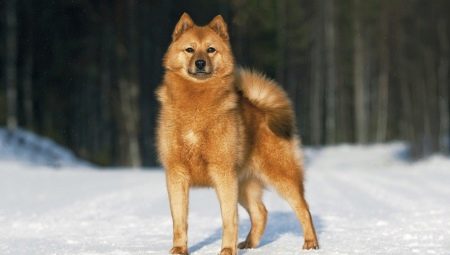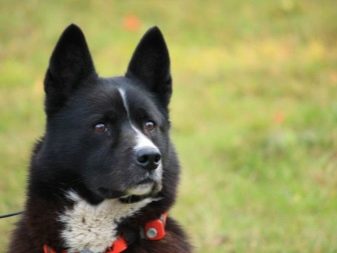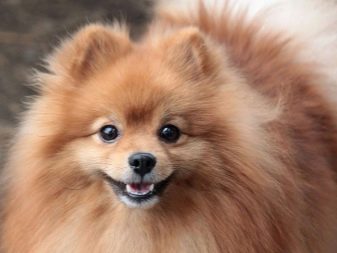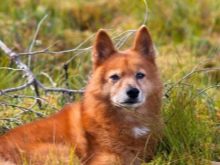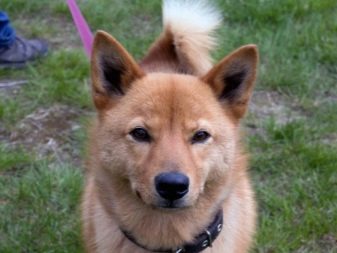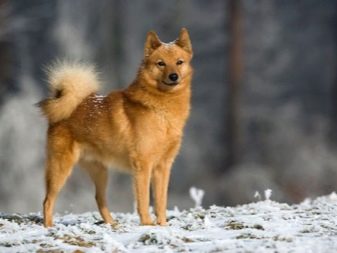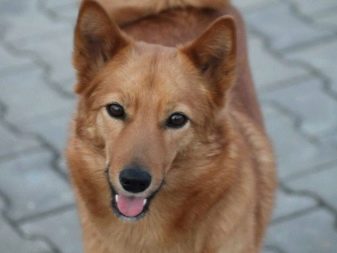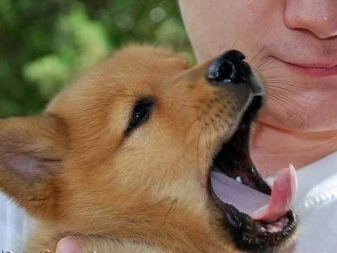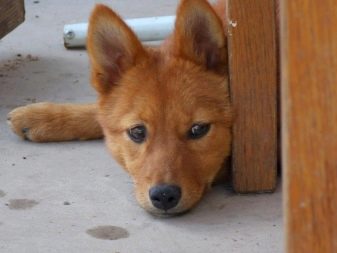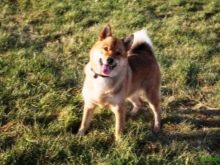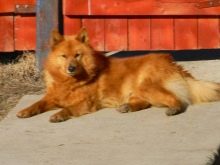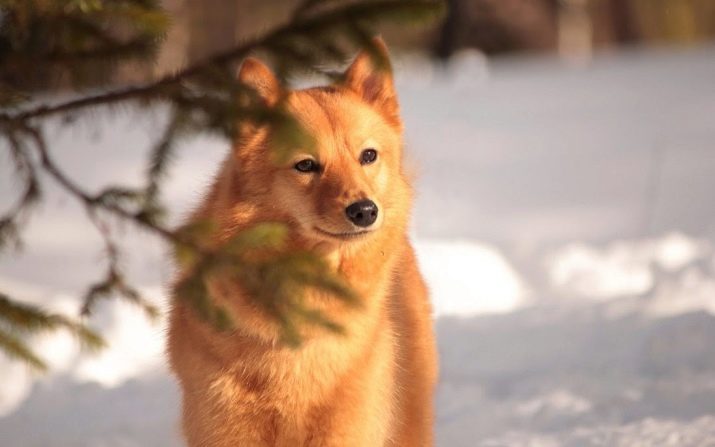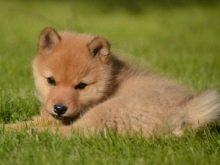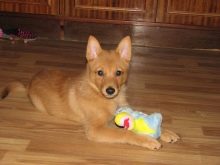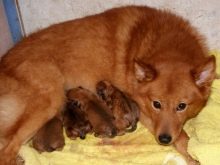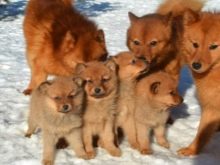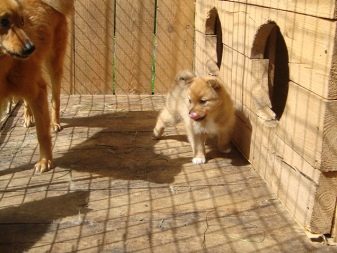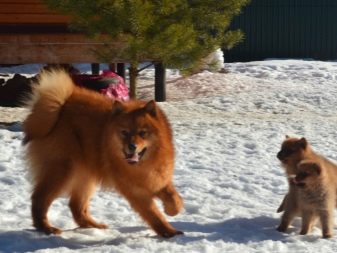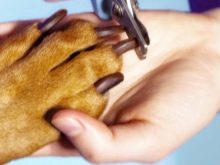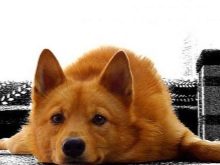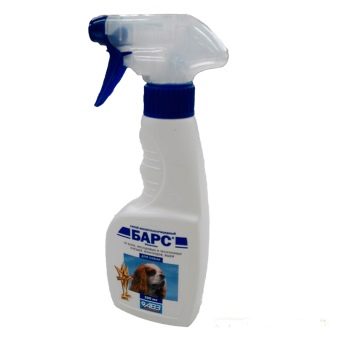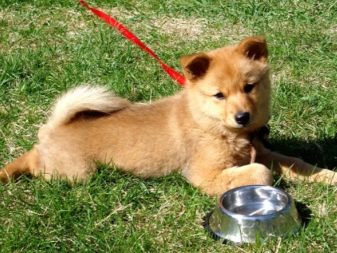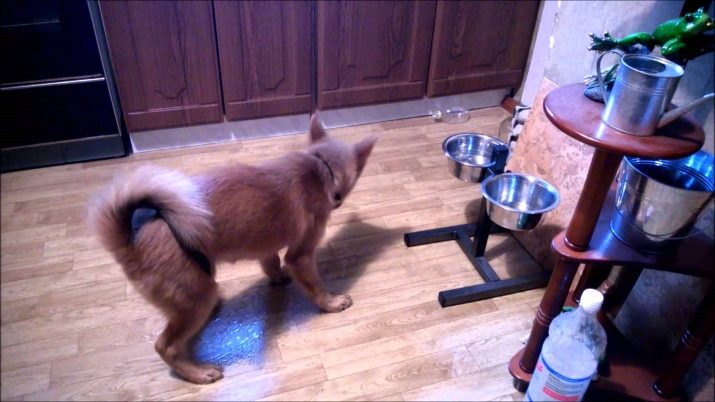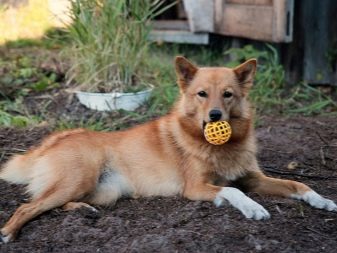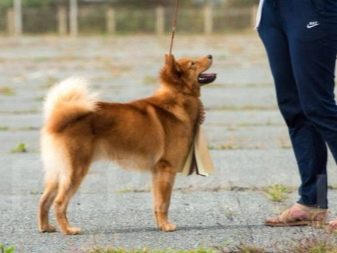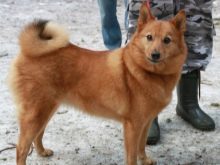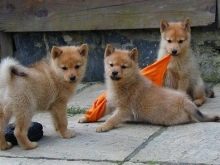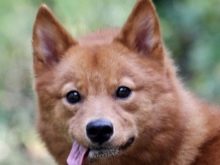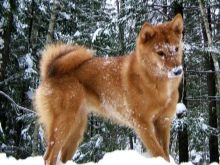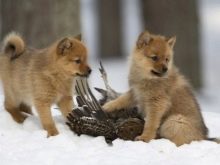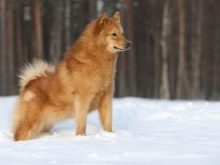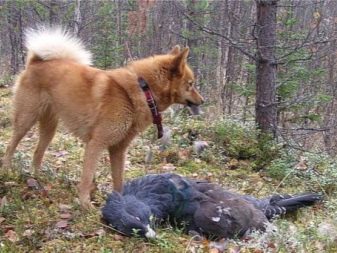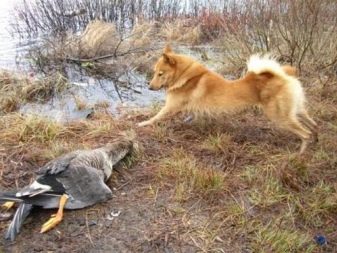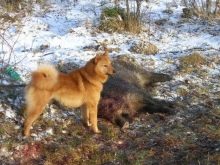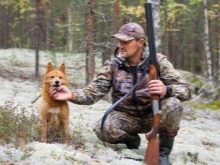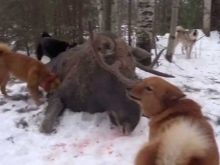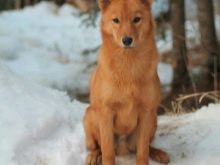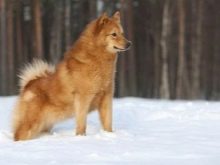Karelian-Finnish Laika is an excellent dog, able to demonstrate its best working qualities in the most difficult conditions. Once the appearance of this breed was a forced step related to the need to provide fur-trappers with a reliable companion with an excellent sense of smell. But she was never destined to find official status. The initially used breeding material after many years led to the unification of the Karelian-Finnish huskies with Finnish Spitz - it is under this name that the breed today appears at exhibitions.
History of
For the first time, experiments on breeding the breed called Karelian-Finnish Laika were conducted more than 100 years ago, at the beginning of the 20th century. Metisnoe livestock combined features of their parents - Olonets and Karelian dogs of commercial purpose with Finnish spitz. The resulting livestock had a bright red color and significantly better performance than the original producers. In order to avoid closely interbreeding in breeding, most often used blood infusion of Finnish Spitz, writing them down to the producers already as representatives of the new breed.
The resulting half-breed was considered purebred and, until 1984, it suited both hunters and representatives of the federation. But as the livestock was forming, it became clear that without uniting with the Finnish spitz it was pointless to conduct further selection. Moreover, the lack of mutual understanding with the Finns did not allow the breed to be registered at the international level, because its name contained a foreign toponym. It was also impossible to name dogs exclusively with Karelian huskies, by that time almost 90% of the livestock was covered.
The creation of the RCF also did not bring clarity - by automatically accepting all the requirements of FCI, it simply excluded the very possibility of legalizing the popular commercial breed. The standard of the organization provides only the option "Finnish Spitz". Since 2006, all the livestock, taken into account by the clubs at that time, have been officially referred to them. The reason for the disappearance of the very name of the Karelian-Finnish husky was the agreement signed with the FKC (the Finnish analogue of RKF) to merge the two branches of selection into one common standard.
In fact, this once deprived one of the most promising domestic breeds of dogs every chance of official recognition. And many breeders do not agree that the domestic breeding material was not enough to highlight the authentic, local livestock line. Breeding Karelian husky - a descendant of a similar Old Karelian breed, continues by enthusiasts today.
Moreover, her livestock is radically different from the Finnish Spitz with unsurpassed performance.
Breed characteristic
Characteristics of puppies and standards of adult Karelian-Finnish huskies today correspond to those adopted for Finnish spitz. Representatives of the breed live for a long time - up to 12-14 years, keeping physical activity practically throughout this time.
Karelian-Finnish Laika looks impressive. Red fluffy wool has a honey warm shade, eyes of brown or black color give expressiveness to the muzzle.A compact body and a small height at the withers - no more than 42-50 cm for males and 38-46 cm for females, allow them to maintain their dexterity in hunting for the beast. The standardized description also includes restrictions on body weight - the weight of dogs, depending on the sex, varies from 7 to 13 kg.
The main differences between Karelian huskies and Finnish Spitz were always in their external appearance. The foreign breed, the standard of which is now accepted as a basis, initially had a more attractive phenotype. At the same time, when breeding Karelian husky, emphasis was placed on working qualities. Today, a compromise has not been found, it is just that in the standard of the Finnish spitz two branches are bred at once - working and decorative.
Compact size, medium height and a dry, strong constitution are not the only pedigree attributes that this dog is famous for.
Finnish Spitz (previously - Karelian-Finnish Laika) has the following characteristics.
- Strong square case. The back does not sag, the withers are well defined, the croup is clearly delineated, oblique, the abdomen is taut.
- Neck visually short, with abundant edge, in fact, it is proportional to the body length.
- Limbs straight and strong, set in parallel. Hind legs have massive femoral parts, muscular tibiae, hock is low located. The paw is compact, firmly compressed, round in shape, the front ones give way to the rear ones in size.
- Tail long, reaching to the hock. At the base forms a sharp bend, thrown on his back, with the tip hung down.
- Coat relatively short on the legs and head, body, tail, hips well pubescent. The dog's fur is lush, does not fit the body, in males in the shoulder area, the guard hairs are almost parallel to the body. The color characteristic of the Finnish Spitz - red, brighter on the back, on the cheekbones, on the ears, on the legs, on the tail, is noticeably lighter. The presence of a white strip on the chest, specks on the legs.
- Head compact, oval at the top, on the sides of a slightly convex shape. The nape and brows are not too pronounced, the frontal furrow is smoothed. Stop clearly defined, but without excessive selection. The head looks harmoniously relative to the body. The muzzle is dry and narrow, has a smooth back without humpbacks.
- Eyes planted obliquely, have an almond shape, small size. The iris is always dark, with no exceptions.
- Teeth smooth and strong, with a symmetrical position. Only scissor bite is allowed. Jaws are strong.
The defects of the breed, according to the standard, include the enlargement of the head and muzzle, the massiveness of the backbone, excessive or too weak twisting of the tail. Also disadvantages include the weak development of the lower jaw, soft pasterns, the wrong set of ears.
Finnish spitz-dogs with iris of yellow or blue color, large white markings on the body, chest, legs, wavy hair are subject to breeding. Another disadvantage is the noseless discoloration. Aggressive, vicious animals are not allowed to mating.
Character and behavior
Karelian-Finnish Laika is a cheerful dog with a lively mind and beautiful character. The animal has its own dignity and requires respect. In animal training you should not show authoritarianism and aggression.
Patience and tenderness from the Finnish Spitz can achieve perfect obedience. To understand the mood of the animal is very simple - an upset or irritated pet straightens its tail, usually thrown over its back.
In their youth and childhood, Karelian-Finnish huskies are incredibly dependent on the owner, their attachment may well create some problems in the content. Pet bored, actively expresses his feelings with a loud bark. But extreme obedience and affection as an animal grows up is replaced by independence, turning into stubbornness. However, the Finnish spitz perfectly feel the mood of the owner and to achieve from them obedience is still possible.
Dogs treat strangers with caution, they hardly endure their presence in the territory they consider to be theirs. This makes the Karelian-Finnish husky a good guard, able to warn the owner about the approach of strangers. Animals are tolerant to children, patient enough, able to become good playmates. But it is better to offer communication with the dog to schoolchildren or teenagers - toddlers may be too undead.
In assessing the behavior of the Karelian-Finnish huskies, consider the following points.
- Hunting instinct. An animal, in the absence of field trips, will satisfy its needs for tracking and catching game in the territory of a house or apartment. It is necessary to provide a sufficiently intense burst of energy to the dog.
- Cunning and independence. These two qualities greatly influence the learning process, as the dog quickly cools off to monotonous activities.
- Intolerance and jealousy of other animals. If in the host family the Karelian-Finnish Laika easily adapts and finds its place in the hierarchy, then with existing pets there can never be a common language. It is necessary to be prepared for the fact that there will be only one dog in the house. However, you can make a couple of Finnish Spitz - the tribesmen get along quite well.
- Loud bark. The dog gives a voice for any reason, always and everywhere. Noise breed limits the possibility of its content in a city apartment.
- Fearlessness and courage. The real hero - Karelian-Finnish Laika is genetically deprived of the feeling of fear of danger. At the same time during the hunt the animal does not lose its head and easily finds an advantageous position to attack, while remaining invulnerable.
How to choose a puppy?
When choosing a puppy of Karelian-Finnish husky, it is very important to correctly determine the sex of the pet. Boys are more freedom loving and free. Girls are much more tender, easier to train. It is necessary to take the baby into the house not earlier than one and a half month, experienced breeders advise to postpone acquaintance until the dog reaches 3 months.
The older the puppies, the easier it will be to distinguish between his inclinations and predispositions.
For hunting, you can choose an animal that is not perfect on the exterior, but from truly proven manufacturers with developed working qualities. To participate in shows and exhibitions, you must initially choose Finnish Spitz from the parents of the show class with a flawless appearance. It is necessary to start a dog “for the soul” only if the owner is ready to fully provide the animal with the necessary volumes of physical activity.
When choosing a puppy you should pay attention to the following important and significant points:
- age of parental pair - it is bad when dogs that are less than one and a half years old are allowed to breed;
- availability of workers and champion diplomas from manufacturers - this is good, but does not guarantee the inheritance of qualities by offspring;
- set ears - from 6 weeks they take the standard for the breed position;
- number of puppies in litter - the optimal number is not more than 5;
- time of birth - The most fluffy fur coats in winter Finnish Spitz;
- condition of the musculoskeletal system - there should be no signs of rickets;
- general view of a pet - It must be healthy, not emaciated, active.
RKF is obligatory if the dog is planned to be bred in the future. There are certified nurseries in Russia in Karelia, Moscow, St. Petersburg, Arkhangelsk, in the Urals and in Siberia.
Conditions for content
It is possible to create comfortable conditions for keeping Karelian-Finnish likes only in direct contact with the owner. This is a domestic breed that is not suitable for chain or captive content. Fluffy wool is still not good enough to heat the animal in the harsh Russian frosts. In the warm season, it is permissible to be kept in an open-air cage, connected to the house and equipped with a shed, a cottage, and everything necessary for a comfortable life.
A puppy in an apartment or house must definitely allocate his own place, which he will know. A bed is settled here, toys are placed. The dog must restrict access to the master bedroom - small Finnish spitz tend to climb into the bed, and if you go to meet them, you will have to share the bed with your pet for many years. Weaning a puppy to take place on the bed can be, the first time he stays in the house is covering the surface with newspapers.
Walking Karelian-Finnish huskies start with one and a half months. For a puppy, the stay on the street should not be too long - 15-20 minutes will suffice. Gradually, this time increases.
Adult dogs need to walk at least 2 hours twice a day.
Care instructions
The procedure of caring for the Karelian-Finnish husky is reduced mainly to thoroughly combing the dog twice a year - during the molting period. The rest of the time, the pet does not lose its coat, it has practically no specific smell. Hard guard hair is not prone to tangling, combing a pet twice a week is enough with a stiff iron brush. Bathing procedure is carried out no more than 3 times during the year. After contact with the swamp or river microflora on hunting, the wool is rinsed with clean water.
Eye care comes down to periodic inspection and morning removal of lumps forming in the corners of the eyes. Hygiene procedures are performed with a cotton swab dipped in camomile infusion. When the nature of the discharge changes to purulent, with redness of the eyeball, excessive tearing, it is necessary to show the pet to the veterinarian.
The claws are clipped monthly, and the ears are inspected weekly. It requires dogs and regular brushing of teeth, which must be repeated at least once every 3-4 days. The procedure is performed using a special nozzle and veterinary paste. Home dental plaque is removed with special chewing sticks from the pet shop, but it is better to periodically remove accumulated deposits in the veterinarian's office.
An important part of pet care is protection from blood-sucking skin parasites.
As soon as the tick season begins, both repellent collars and sprays or other chemical compounds should be used to protect the husky wool.
The Finnish Spitz, often in the forest, should be regularly inspected upon arrival home for ectoparasites.
Power Rules
Compact Finnish Spitz are not picky in the choice of diet. You can feed them with a full-fledged finished product from the age of three months. Dogs are easily accustomed to the standard mode and are not inclined to beg for a supplement. Dry food they are given only with mandatory access to clean water. Teenagers are also given up to 20% of fresh lean meat - beef, veal, it is possible to use pre-frozen foods.
Feeding natural products involves cutting food into pieces. - It is not recommended to give mince or heavily chopped food. From 7 weeks huskies are allowed to give bone cartilage of animals and birds. Bones are given to chew no earlier than three months of age. From cereals in the first months it is recommended to give semolina in milk. From 3-4 months they give oatmeal, rice, buckwheat, millet, cooked in meat broth.
Fermented milk products, fresh vegetables - carrots, broccoli, sea fish fillets are useful for adults of Karelian-Finnish likes. It is useful to offer the dog dried fruit and cheese as a treat. With natural feeding Be sure to include in the diet of animal vitamin and mineral supplements.
It is very important to take into account the fact that Karelian-Finnish huskies do not differ in gluttony. Dogs of this breed need small portions of food, 15 minutes after feeding the bowl is removed, food remains are utilized.
This allows you to discipline the animal, shows him that the rules in the house dictates the owner.A puppy is fed up to 6 times a day for a month and a half, the eight-month-old animal already goes on an adult diet with two meals a day.
Upbringing and training
Karelian-Finnish huskies are animals that can be easily trained at a young age. But as they get older, learning new skills becomes a problem. They quickly lose interest in learning, easily manipulate the owner, asking for delicious treats. Up to 30 lessons are spent on practicing one team - this seriously delays the process of mastering even the basic set of signals from the host.
It is recommended to walk the freedom-loving Finnish Spitz exclusively on a leash, releasing it from the leash only outdoors, when going hunting.
The standard learning process is always directly related to the dog’s mastering a basic set of commands. The first of these is the recognition of their own nicknames. A three-month puppy should know its place, come to the call of the owner, to distinguish prohibitions. The commands "Sit", "Lie", "Stand" are studied by the age of six months.
Babies born in spring can already be accustomed to swimming by the summer so that the dog is not afraid of water, including fast rivers and cold streams.. Schooling begins with walks through puddles and shallow water. Then the dog can be allowed to swim in shallow waters. Raising this skill is especially important for animals that are acquired for use in hunting. After each swim in an open pond, a dog needs a shower, allowing it to wash away dirt, dust, and bacterial microflora.
As teenagers, Karelian-Finnish huskies have impressive destructive power. At home they spoil and gnaw everything, despite the prohibitions - in this way an active dog knows the world. Leaving them for a long time alone is not recommended.
In the countryside, Finnish Spitz has other temptations. The ineradicable hunting instinct provokes a craving for an attack on poultry. If such an incident happened for the first time, the command “No” is usually enough.
When strangling a chicken or a goose, a dog must be punished immediately, immediately. Otherwise, further such unseemly behavior may become a habit.
Hunting with a dog
Karelian-Finnish husky is a hunting breed famous for its versatility. But experienced hunters consider it the optimal choice for the harvesting of small fur-bearing animals or wood grouses. Hunting with a dog in this case requires almost no effort - it searches for itself, stops, frightens game, brings the beast shot and the bird.
Preparation for going to the forest is made from four months of age, but it is recommended to take into account the intellectual development of a particular animal.
If there is no interest in the beast, the training is postponed for one to two months. At a certain intensity of training, experienced hunters manage to prepare the Carelek for the bear's dressing. But this approach can be attributed rather to the category of demonstration performances - in the ordinary hunt for such feats only very patient and clever likes are capable.
Awakening instincts in the Finnish Spitz often happens with a big delay - at the age of about one and a half years. Do not worry, but work on the awakening of hunting interest should be gradually carried out. Puppy give battered birds, animal skins. In the presence of a more experienced dog, take it on the pre-cutter as an example. Young Karelian-Finnish huskies learn well from the example of their older comrade.
When hunting for a large animal, dogs of this breed demonstrate amazing accuracy and caution. Deft and agile Karelian-Finnish Laika can keep a distance from an angry beast, and her clear voice allows the boar to divert the attention of the boar. Worth adding that in their ability to prey a game, this persistent and courageous dog has almost no equal, just like its ancestor of the Old Karelian breed.
Suitable nicknames
First of all, we should consider authentic Finnish names that are well suited to representatives of this unique breed. In order for the puppy to quickly remember his nickname, it is recommended to choose a short and sonorous combination of letters with a solid ending.
Nicknames associated with local Karelian, Russian toponyms or names of animals that are harvested with the help of dogs of this breed are no less popular among hunters. Males are characterized by names: Brave, Fast, Sable, Ural, Aldan, Abrek, Nabat, Suyan, Falk, Yarro. Owners of Finnish Spitz girls can be recommended to choose such names as Squirrel, Iris, Accha, Vlasta, Gokto, Egoza, Zatika, Lange, Ora, Secchi, Elf.
Reviews
The owners of Karelian-Finnish huskies always celebrate the cheerful nature and the rare beauty of their pets. Dogs are kind and tender to family members, girls are especially attached to children, often become good companions in their active games. Hunting abilities many Karelian-Finnish huskies show already at the age of six months.
Owner reviews also always include a mention of the benefits of walks that you have to do with your pet. 2-3 hours a day in the fresh air is enough that she did not miss in the absence of the owner.
The Finnish Spitz is an ideal companion for runners and cyclists. The dog is almost tireless and able to withstand hours of marathons without any extra effort.
Hunter owners consider the Karelian-Finnish husky of one of the best commercial species. It is universal, indispensable in the extraction of small fur animals and birds, does not succumb to a bear or a boar. The animal works in water as well as the cops, it often goes on duck hunting. And the dog does not spoil the bird and delivers it to the owner safe and sound.
You can learn more about raising Karelian-Finnish husky in the next video.
